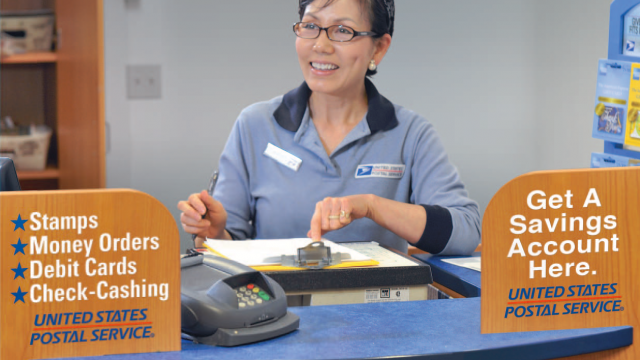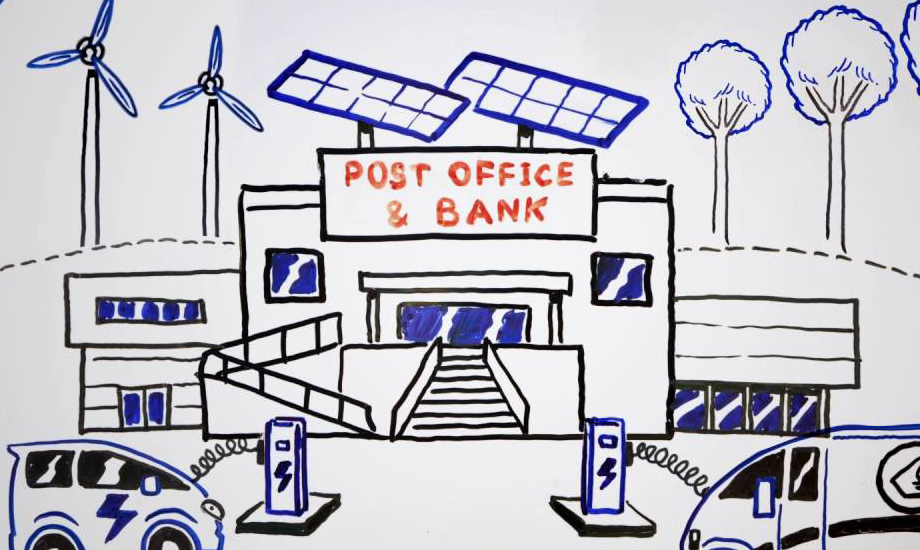
This is Part 7 in a 10-part series on public banking and economic justice. Read parts 1, 2, 3, 4, 5, 6, 7, 8, 9 and 10.
I spoke with Katherine Isaac, coordinator for the Campaign for Postal Banking, at a recent gathering of public banking advocates. The last time I’d seen her was in Washington, DC in 2015 when I was part of an effort to push the leadership of the American Postal Workers Union to support the revival of the U.S. Postal Service's decades-long banking services. I asked Isaac what postal banking had in common with the larger movement for public banking.
“They both fit into something bigger,” she said, clarifying that part of the vision of the postal service, postal banks and public banks was “the value of the public sector.”
“I don’t want to concede that people hate the government,” she told me, so she was determined to keep pushing to bring back post office banking in whatever form was feasible.
But as advocates for banking reform know, feasibility is an interesting concept.
Giving the Poor the Same as the Rich
Over half of all Americans live in a constant state of economic insecurity, and tens of millions of those Americans lack access to banking services. While lack of access isn’t the root cause of economic insecurity, it exacerbates it, making it very expensive to be poor and hard to get out in front of it.
To cash checks, millions of Americans pay check-cashing stores part of their take-home pay. To pay for emergencies and sometimes just to pay the rent, millions more Americans take out high-interest payday loans from those same businesses. These loans can ruin lives and their impacts fall harder on vulnerable people, from people of color to domestic violence victims.
Despite successful efforts by some states in the early 2000s to end the practice, for the most part payday lenders remain undeterred by weak federal regulations, and easily dodge attempts at state-level limits.
Postal banking is both a radical and simple solution to some of the challenges of economic insecurity. The vision of postal banking put forward by senators Bernie Sanders, Elizabeth Warren and, most recently, Kirsten Gillibrand, is to take basic banking services that were once provided (between 1911 and 1967) at very low cost by the USPS, and add small lending (the risks of which the large federal entity could absorb relatively easily) to give people an alternative to high-interest payday loans.
For University of Georgia law professor Mehrsa Baradaran, author of How the Other Half Banks and The Color of Money: Black Banks and the Racial Wealth Gap, the calculus is simple: Governments offer all kinds of services, including financial bailouts, to the wealthy and their banks. Government should offer similar services to the non-wealthy. Potential beneficiaries include over half of the U.S. population.
A Grassroots Effort
Revival of postal banks, with the additional lending component, had been a longtime favorite idea of many activists, banking experts and admirers of the post office before 2014, the year postal banking became a movement. Early that year, the USPS Postal Inspector General released a report calling for the USPS to deliver financial services, including loans.
Marc Armstrong co-founded the Public Banking Institute in 2011, but when he left the organization in 2014, he'd been working with postal unions for several months and talk had developed of introducing public banking options through the USPS. Marc, Ira Dember, Susan Harman and myself formed BankAct, later called Commonomics USA, an organization dedicated to implementing democratic socialist economic policies, with postal banking at the top of our list.
We successfully campaigned for the United States Conference of Mayors to pass a resolution in support of postal banking at their 2014 annual conference. We also joined the Campaign for Postal Banking, a coalition of progressive groups including all the postal unions, the Coalition of Black Trade Unionists, Communication Workers of America, Interfaith Worker Justice, People's Action, Public Citizen and United for a Fair Economy.
Reaction from financial elites and conservative lawmakers was swift. It quickly became apparent that achieving a full postal banking, anti-predatory lending agenda would require a sea change in Congress, as well as a cooperative President. The USPS is overseen by a Board of Governors, whose appointments are controlled by the Committee on Homeland Security and Governmental Affairs, whose members include lobbyists for the payday lending industry and people who’ve gone on record saying the USPS shouldn’t even exist.
The obvious solution to this elite backlash was to fight the postal banking war on multiple fronts. One of those would be the ongoing grassroots campaign, grounded in the experiences of economically insecure Americans lacking banks or access to cash advances in stressful economic times. The other strategy involved encouraging the USPS to adopt smaller, interim financial services not requiring congressional improvement. The workability of those services would wear down resistance to larger changes, and sooner or later, we reasoned, Congress would be populated with enough progressives to implement the larger vision.
Whose Feasibility? Whose “Quiet Work?”
The election of Donald Trump and the maintenance of Congress by Republicans was a bump in the road, but realistically, a Hillary Clinton administration and a slightly more moderate Congress wouldn’t have made much of a difference. A people’s banking system strikes bipartisan terror in the hearts of the elites. At Commonomics USA, we found more and more doors being closed by people in the beltway that should have been behind the larger postal banking/anti-payday lending vision.
The smaller options were good policy, but they weren’t inspiring. They wouldn’t mobilize a mass movement. The best you can achieve working without Congress is the creation of a remittance program. As I told my colleagues in 2015, people need help with remittances and other basic banking services, but people won't march in the streets over those. There is no movement for postal banking without including lending services. We continued to insist that the roll of Gillibrand, Warren, Sanders and other leaders was critical. Keep the large demands coming, creating space for the smaller gestures. Eventually we’ll win.
A recent article by Alan Pyke from the moderate Center for American Progress expresses the more cautionary approach. The title of Pyke’s article, “Gillibrand’s post office banking bill bypasses years of careful, quiet work to kill payday lending,” throws down a rhetorical gauntlet, giving loud voice to the argument that the non-legislative route is key to avoiding existential attacks on the postal service.
To be fair, Pyke does acknowledge the moral force of Gillibrand’s proposal. But the implication is that large, systemic demands are too risky – that it’s better to do “quiet work.” I’ve heard this argument over and over, and I’m genuinely afraid that it privileges cynicism: The cynicism of Democrats who think the New Deal was quaint bills itself as the only alternative to the cynicism of Republicans who literally believe the management practices of Mister Money and Staples are the way we should run the country.
Don’t expect people to go to the polls for that. And sooner or later, you’re going to need people to go to the polls even to preserve your tiny policy tweaks.
Big and Small Demands
The real problem with an exclusively cautious approach is that it doesn’t placate the conservatives. Even a baby step towards egalitarianism is a step too far for them. And then, when they take the hammer to those small steps, there’s no longer a mass movement behind postal banking to even save the small things. Republicans (and some Democrats) will try to destroy the Post Office no matter what we do.
I understand the long game. I just think it should include both the large and small demands – and it shouldn't include the fear of making powerful people angry by demanding too much. They’re always already angry.
“We’re doing a lot of internal education” of postal union members, Katherine Isaac told me. Many postal workers could use postal banking services themselves. And postal workers have the confidence in their work and their organization to branch into banking, if they’re empowered to do so by their governing bodies.
That’s part of the long game, and Isaac counted herself among those postal banking campaigners who want to begin with things the USPS can do “without an act of Congress,” lest we go for a big idea, “lose, and set ourselves back.”
But I hope that activists at all levels see how demands for radical reforms can boost the survivability of smaller reforms. Sure, it’s risky, but in my opinion it’s less risky than hiding in the shadows and not building your activist army through appeals to big values and big policies. A broad vision of human solidarity has a lot to offer the postal banking movement, as Baradaran, Meagan Day and others have been arguing. Just as the quest for state- and city-owned public banks requires mass mobilization at local levels, if we want public banks, we need to elect the right officials nationally. And doing that means having a courageous economic vision – not an exclusively pragmatic and cautious one.
READ PARTS 1, 2, 3, 4, 5, 6, 7, 8, 9, 10
Matt Stannard is Policy Director at Commonomics USA and a member of the Public Banking Institute’s Board of Directors. Matt Stannard writes about cooperative economics, law, politics and culture. His blog is Cowboys on the Commons. Click to read more by Matt on Occupy.com. You can listen to a conversation between Matt Stannard and Marc Armstrong about postal banking here.












